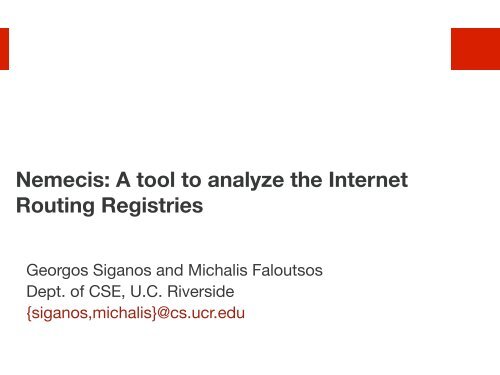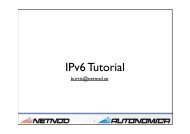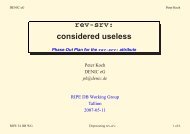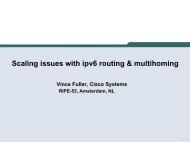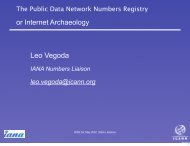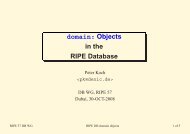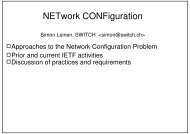Nemecis: A tool to analyze the Internet Routing Registries
Nemecis: A tool to analyze the Internet Routing Registries
Nemecis: A tool to analyze the Internet Routing Registries
You also want an ePaper? Increase the reach of your titles
YUMPU automatically turns print PDFs into web optimized ePapers that Google loves.
<strong>Nemecis</strong>: A <strong><strong>to</strong>ol</strong> <strong>to</strong> <strong>analyze</strong> <strong>the</strong> <strong>Internet</strong><br />
<strong>Routing</strong> <strong>Registries</strong><br />
Georgos Siganos and Michalis Faloutsos<br />
Dept. of CSE, U.C. Riverside<br />
{siganos,michalis}@cs.ucr.edu
Problem<br />
We need cooperation between Au<strong>to</strong>nomous<br />
Systems.<br />
<strong>Internet</strong> <strong>Routing</strong> <strong>Registries</strong> (IRR) is an attempt<br />
IRR: text based reposi<strong>to</strong>ry of BGP related policy<br />
Problem: IRR have not reached <strong>the</strong>ir full potential<br />
has not been explored<br />
its accuracy has not been quantified<br />
is very complicated described in RPSL
Contribution: NEMECIS<br />
We provide a framework for BGP policy analysis<br />
We quantify <strong>the</strong> accuracy of <strong>the</strong> IRR<br />
Check <strong>the</strong> policies for correctness / freshness<br />
This was a long term goal of RIPE<br />
We develop a <strong><strong>to</strong>ol</strong> <strong>to</strong> <strong>analyze</strong> IRR data<br />
We use a relational database <strong>to</strong> s<strong>to</strong>re <strong>the</strong> policies<br />
Web based front-end for <strong>the</strong> database
The Rest of this talk<br />
IRR and RPSL<br />
Key concepts of <strong>Nemecis</strong><br />
Quality of Information in IRR<br />
<strong>Nemecis</strong> web-based interface<br />
Conclusions
How is policy described in RPSL<br />
Policy description resembles BGP filtering<br />
Routes: from AS1 accept 138.23.0.0/16<br />
Regular expressions on <strong>the</strong> AS Path: from AS1 accept<br />
<br />
Communities: from AS1 accept community(xxx:yyy)<br />
RPSL provides high level structures <strong>to</strong> group routes<br />
AS numbers (AS1): all routes <strong>the</strong> AS registers<br />
AS-SET: AS numbers and o<strong>the</strong>r AS-SETS<br />
ROUTE-SET: routes and o<strong>the</strong>r ROUTE_SETS
Example of An RPSL Description<br />
route: 138.23.0.0/16<br />
origin: AS4 Registered/Maintained by AS4<br />
AS1<br />
as-set:<br />
members:<br />
AS3-ISP<br />
AS3, AS5<br />
Registered/Maintained by AS3<br />
AS2<br />
as-set:<br />
members:<br />
aut-num:<br />
import:<br />
import:<br />
import:<br />
export:<br />
export:<br />
export:<br />
AS2-ISP<br />
AS2, AS3-ISP, AS4<br />
AS2<br />
from AS1 accept ANY<br />
from AS3 accept AS3-ISP<br />
from AS4 accept <br />
<strong>to</strong> AS3 announce ANY<br />
<strong>to</strong> AS4 announce ANY<br />
<strong>to</strong> AS1 announce AS2-ISP<br />
AS4 AS3<br />
AS5<br />
Registered/Maintained by AS2
... things can become scary...<br />
aut-num: AS2<br />
import: {<br />
from AS-ANY action pref=10;<br />
accept community.contains(1:1);<br />
from AS-ANY action pref=0; accept ANY;<br />
} refine {<br />
from AS2:AS-CUSTOMERS<br />
accept (PeerAS OR AS2:AS-CUSTOMER:PeerAS)<br />
AND <br />
}<br />
Policies can be thousands of lines long<br />
Sets can contain tens of thousand of members<br />
Inconsistent / out of date policy<br />
AS4<br />
AS1<br />
AS2<br />
AS5<br />
AS3
The Rest of this talk<br />
IRR and RPSL<br />
Key concepts of <strong>Nemecis</strong><br />
Quality of Information in IRR<br />
<strong>Nemecis</strong> web-based interface<br />
Conclusions
<strong>Nemecis</strong>: Three main phases<br />
Create <strong>the</strong> database:<br />
Parse RPSL policy text, put data in tables<br />
Correlate import and export policies<br />
Export = what I create + what I import<br />
For each export find where it comes from<br />
Find at <strong>the</strong> level of a link: what I do with incoming data<br />
Infer business relations: from link-level model<br />
Examine export policies of two neighbors<br />
If not enough or incomplete, use import policies<br />
Deal with incomplete and inaccurate data
Link Level Export Matrix<br />
Links 1 ... i j<br />
1 x<br />
... x<br />
i x export<br />
j export x<br />
Relation Matrix of an AS: which link I export <strong>to</strong> which<br />
o<strong>the</strong>r AS
AS4-ISP<br />
Hierarchy in sets<br />
AS5-ISP<br />
AS6<br />
AS4<br />
AS4:CUST<br />
AS5<br />
AS2<br />
AS5<br />
AS4<br />
AS2<br />
AS3<br />
AS2 AS3<br />
Our algorithm work wells when ASes maintain <strong>the</strong> hierarchy in <strong>the</strong><br />
sets.<br />
Medium <strong>to</strong> large ASes (connectivity) can have more than one path<br />
<strong>to</strong> an AS. Figuring out if <strong>the</strong>ir policy is correct if <strong>the</strong>y don’t maintain<br />
<strong>the</strong> hierarchy is ‘impossible’.<br />
For example Level3 has one huge route-set.
Policy ‘must’ be symmetric<br />
aut-num:<br />
import:<br />
import:<br />
export:<br />
export:<br />
...<br />
AS1<br />
from AS2 accept AS2<br />
from AS3 accept AS3-ISP<br />
<strong>to</strong> AS2 announce ANY<br />
<strong>to</strong> AS3 announce AS1-ISP<br />
AS2<br />
AS1<br />
AS3<br />
A big problem is <strong>the</strong> difference in time between <strong>the</strong> aut-num object<br />
and <strong>the</strong> sets that it uses. Differences of several months are not<br />
uncommon.<br />
Consider <strong>the</strong> scenario that AS2 is no more a cus<strong>to</strong>mer of AS1. AS1<br />
updates only it’s as-set, but not it’s aut-num record. This problem<br />
will be undetected if we don’t ‘enforce’ symmetry.<br />
Of course we might classify correct policies as incorrect.
4 Simple Business Relations<br />
Business relations can be grouped by <strong>the</strong> export filters
The Rest of this talk<br />
IRR and RPSL<br />
Key concepts of <strong>Nemecis</strong><br />
Quality of Information in IRR<br />
<strong>Nemecis</strong> web-based interface<br />
Conclusions
How many ASes register <strong>the</strong>ir policy<br />
6,500<br />
6,362<br />
Ripe Radb Apnic Rest<br />
16<br />
4,875<br />
12<br />
12<br />
3,250<br />
8<br />
1,625<br />
2,066<br />
2,058<br />
4<br />
6<br />
6<br />
1,061<br />
3<br />
0<br />
ASes Registering Policy<br />
0<br />
Average Degree
Do both peers register “each o<strong>the</strong>r”<br />
80<br />
Ripe Radb Apnic Rest<br />
IRR<br />
60<br />
40<br />
20<br />
49<br />
14 16<br />
6<br />
Both directions exist (%)<br />
Policy of AS1:<br />
from AS2 import B<br />
<strong>to</strong> AS2 export A<br />
Policy of AS2:<br />
from AS1 import A<br />
<strong>to</strong> AS1 export B
Do <strong>the</strong>y use <strong>the</strong> same filter<br />
Ripe Radb Apnic Rest<br />
80<br />
Examples of same filter<br />
60<br />
40<br />
20<br />
49<br />
40<br />
38<br />
56<br />
Policy of AS1:<br />
from AS2 import B<br />
<strong>to</strong> AS2 export A<br />
Policy of AS2:<br />
from AS1 import A<br />
<strong>to</strong> AS1 export B<br />
0<br />
Same filter used(%)
Tests for consistency of IRR<br />
Policy based tests (correctness)<br />
import-export consistency<br />
Link-Level policy is symmetric<br />
BGP based tests (freshness)<br />
All peers of an AS, as found in BGP, must be<br />
registered in IRR.<br />
The high-level policy of an AS should be <strong>the</strong> same<br />
in both BGP and in IRR (e.g. Provider <strong>to</strong><br />
Cus<strong>to</strong>mer).
100<br />
Quantify <strong>the</strong> Accuracy of IRR<br />
Ripe Radb Apnic Rest<br />
75<br />
80<br />
77<br />
84<br />
72<br />
50<br />
25<br />
0<br />
Pass Policy Tests(%)<br />
34<br />
25<br />
15 14<br />
Pass BGP & Policy Tests(%)
The Rest of this talk<br />
IRR and RPSL<br />
Key concepts of <strong>Nemecis</strong><br />
Quality of Information in IRR<br />
<strong>Nemecis</strong> web-based interface<br />
Conclusions
http://ira.cs.ucr.edu:8080/<strong>Nemecis</strong>
List of <strong>the</strong> <strong>Registries</strong>
Inside RIPE !!!
Missing objects in RIPE !!!!
INSIDE AN AUT-NUM IN RIPE
RPSL OF POLICY
EXTERNAL WARNINGS
INTERNAL WARNINGS
IMPORT EXPORT CORRELATIONS
The Rest of this talk<br />
IRR and RPSL<br />
Key concepts of <strong>Nemecis</strong><br />
Quality of Information in IRR<br />
<strong>Nemecis</strong> web-based interface<br />
Conclusion
Questions:<br />
Is anyone using <strong>the</strong> aut-num record<br />
What could be an actual use<br />
Should ‘we’ revisit <strong>the</strong> requirements for cooperation<br />
What information should <strong>the</strong> registries contain<br />
Who should operate <strong>the</strong>se registries<br />
Do ‘we’ need a more human-centered IRR
Conclusions<br />
The first effort <strong>to</strong> quantify <strong>the</strong> consistency of IRR<br />
RIPE is <strong>the</strong> best registry (over 2100 ASes)<br />
Useful information exists in <strong>the</strong> <strong>Registries</strong>.<br />
We are actively seeking feedback from <strong>the</strong> community.<br />
Is our <strong><strong>to</strong>ol</strong> helpful <strong>to</strong> you<br />
How can we improve it<br />
To use our demo please visit:<br />
http://ira.cs.ucr.edu:8080/<strong>Nemecis</strong>


